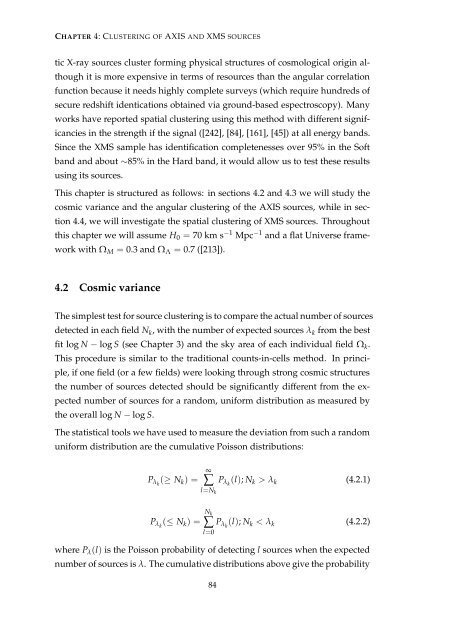pdf - SRON
pdf - SRON
pdf - SRON
Create successful ePaper yourself
Turn your PDF publications into a flip-book with our unique Google optimized e-Paper software.
CHAPTER 4: CLUSTERING OF AXIS AND XMS SOURCES<br />
tic X-ray sources cluster forming physical structures of cosmological origin although<br />
it is more expensive in terms of resources than the angular correlation<br />
function because it needs highly complete surveys (which require hundreds of<br />
secure redshift identications obtained via ground-based espectroscopy). Many<br />
works have reported spatial clustering using this method with different significancies<br />
in the strength if the signal ([242], [84], [161], [45]) at all energy bands.<br />
Since the XMS sample has identification completenesses over 95% in the Soft<br />
band and about ∼85% in the Hard band, it would allow us to test these results<br />
using its sources.<br />
This chapter is structured as follows: in sections 4.2 and 4.3 we will study the<br />
cosmic variance and the angular clustering of the AXIS sources, while in section<br />
4.4, we will investigate the spatial clustering of XMS sources. Throughout<br />
this chapter we will assume H 0 = 70 km s −1 Mpc −1 and a flat Universe framework<br />
with Ω M = 0.3 and Ω Λ = 0.7 ([213]).<br />
4.2 Cosmic variance<br />
The simplest test for source clustering is to compare the actual number of sources<br />
detected in each field N k , with the number of expected sources λ k from the best<br />
fit log N − log S (see Chapter 3) and the sky area of each individual field Ω k .<br />
This procedure is similar to the traditional counts-in-cells method. In principle,<br />
if one field (or a few fields) were looking through strong cosmic structures<br />
the number of sources detected should be significantly different from the expected<br />
number of sources for a random, uniform distribution as measured by<br />
the overall log N − log S.<br />
The statistical tools we have used to measure the deviation from such a random<br />
uniform distribution are the cumulative Poisson distributions:<br />
P λk (≥ N k ) =<br />
∞<br />
∑<br />
l=N k<br />
P λk (l); N k > λ k (4.2.1)<br />
P λk (≤ N k ) =<br />
N k<br />
∑ P λk (l); N k < λ k (4.2.2)<br />
l=0<br />
where P λ (l) is the Poisson probability of detecting l sources when the expected<br />
number of sources is λ. The cumulative distributions above give the probability<br />
84
















